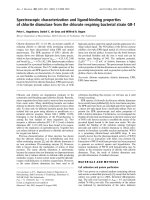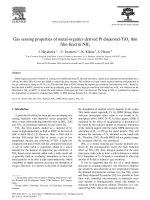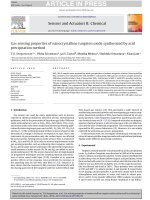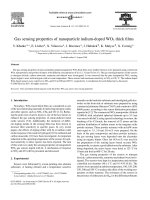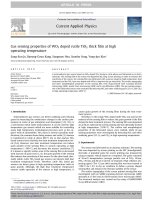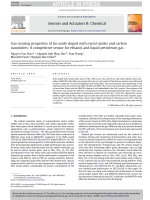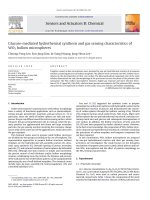controlled synthesis and gas sensing properties of hollow sea urchin like
Bạn đang xem bản rút gọn của tài liệu. Xem và tải ngay bản đầy đủ của tài liệu tại đây (1.68 MB, 9 trang )
Sensors and Actuators B 141 (2009) 381–389
Contents lists available at ScienceDirect
Sensors and Actuators B: Chemical
journal homepage: www.elsevier.com/locate/snb
Controlled synthesis and gas-sensing properties of hollow sea urchin-like
␣-Fe
2
O
3
nanostructures and ␣-Fe
2
O
3
nanocubes
Fenghua Zhang, Heqing Yang
∗
, Xiaoli Xie, Li Li, Lihui Zhang, Jie Yu, Hua Zhao, Bin Liu
Key Laboratory of Macromolecular Science of Shaanxi Province, School of Chemistry and Materials Science, Shaanxi Normal University, Xi’an 710062, China
article info
Article history:
Received 4 September 2008
Received in revised form 28 June 2009
Accepted 30 June 2009
Available online 9 July 2009
Keywords:
␣-Fe
2
O
3
Hollow sea urchin-like nanostructure
Nanocubes
Gas sensors
abstract
Hollow sea urchin-like ␣-Fe
2
O
3
nanostructures were successfully synthesized by a hydrothermal
approach using FeCl
3
and Na
2
SO
4
as raw materials, and subsequent annealing in air at 600
◦
C for 2 h. The
hollow sea urchin-like ␣-Fe
2
O
3
nanostructures with the diameters of 2–4.5 m consist of well-aligned
␣-Fe
2
O
3
nanorods with an average length of about 1 m growing radially from the centers of the nanos-
tructures, have a hollow interior with a diameter of about 2 m. ␣-Fe
2
O
3
nanocubes with a diameter of
700–900 nm were directly obtained by a hydrothermal reaction of FeCl
3
at 140
◦
C for 12 h. The response
S
r
(S
r
= R
a
/R
g
) of the hollow sea urchin-like ␣-Fe
2
O
3
nanostructures reached 2.4, 7.5, 5.9, 14.0 and 7.5 to
56 ppm ammonia, 32 ppm formaldehyde, 18 ppm triethylamine, 34 ppm acetone, and 42ppm ethanol,
respectively, which was excess twice that of the ␣-Fe
2
O
3
nanocubes and the nanoparticle aggregations.
Our results demonstrated that the hollow sea urchin-like ␣-Fe
2
O
3
nanostructures were very promising
for gas sensors for the detection of flammable and/or toxic gases with good-sensing characteristics.
© 2009 Elsevier B.V. All rights reserved.
1. Introduction
Ammonia and various volatile organic compounds have been
released in high quantities into the atmosphere as a result of human
activities, and have generated environmental risks. Chemical sen-
sors for the detection of these flammable and/or toxic gases play
a very important role in chemical industries, environmental pro-
tection, public safety and human health. Metal oxides [1–4], such
as SnO
2
, ZnO, Fe
2
O
3
and V
2
O
5
, function as gas-sensitive materials
by changing their resistance due to exposure to oxidizing or reduc-
ing gases. Nevertheless, there are still some critical limitations to
be overcome for the commercial sensors based on particulate or
thin-film semiconductor metal oxides, such as limited maximum
sensitivity, high working temperatures and lack of long-term sta-
bility [5]. Recently, nanorods, nanowires and nanoribbons of metal
oxides were used to fabricate sensors; the results indicate that one-
dimensional (1-D) nanomaterials are promising for highly sensitive
chemical sensors [5]. Therefore, the fabrication of the metal oxide
nanomaterials with a defined size and shape for gas sensor applica-
tion is currently a major focus of nanoscience and nanotechnology.
Hematite (␣-Fe
2
O
3
), the most stable iron oxide with n-type
semiconducting properties (E
g
= 2.1eV) under ambient conditions,
is widely used as catalysts, pigments, gas sensors, and electrode
materials [3], owing to its low cost, high resistance to corro-
∗
Corresponding author. Fax: +86 29 85307774.
E-mail address: (H. Yang).
sion, and environmentally friendly properties. The previous studies
mainly focused on the ␣-Fe
2
O
3
films [6–11] and powders [12,13].
Stimulated by both the promising applications of iron oxides and
the novel chemical and physical properties of nanoscale mate-
rials, considerable efforts have been made in the synthesis of
␣-Fe
2
O
3
nanostructured materials with different morphologies.
Up to now, a variety of ␣-Fe
2
O
3
nanostructured materials in
various geometrical morphologies have been successfully fabri-
cated, such as nanoparticles [14], nanotubes [15], nanowires [16],
nanobelts [16], nanocubes [17], nanorods [18], spindles [19], hollow
spheres [20,21], nanoplates [22], nanorings [23], rhombohedra [24]
and complex hierarchical structures constructed with nanoscale
building blocks [25–30]. In particular, three-dimensional (3-D)
superstructures assembled with one-dimensional nanorods have
attracted much attention because of their unique properties and
potential applications [28–30]. However, to our knowledge, the
synthesis of hollow sea urchin-like ␣-Fe
2
O
3
nanostructures has
not been reported until now. The hollow nanostructures have
widespread potential applications in catalysts, gas sensors, drug
delivery, etc., owing to their higher specific surface area and lower
density.
Recently, the nanorods [3], nanotubes [15], hollow spheres with
a mesoporous shell [20], porous nanospheres [21], nanorings [23]
and flutelike porous nanorods and hexapod-like nanostructures
[31] of ␣-Fe
2
O
3
have been used to fabricate gas sensors for the
detection of ethanol, acetone, 92
#
gasoline, heptane, hydrogen,
formaldehyde, toluene, acetic acid and ammonia. However, they
did not investigate the stability of the sensors even though stability
0925-4005/$ – see front matter © 2009 Elsevier B.V. All rights reserved.
doi:10.1016/j.snb.2009.06.049
382 F. Zhang et al. / Sensors and Actuators B 141 (2009) 381–389
is one of the most important parameters of sensors. In addition, the
sensing properties of hollow sea urchin-like ␣-Fe
2
O
3
nanostruc-
tures and ␣-Fe
2
O
3
nanocubes have not been studied until now.
In this paper, we report on controlled synthesis of hollow sea
urchin-like ␣-Fe
2
O
3
nanostructures and ␣-Fe
2
O
3
nanocubes. Con-
trol over the both ␣-Fe
2
O
3
nanostructures were achieved by adding
different anions in the Fe
3+
–H
2
O hydrothermal system. To the
best of our knowledge, this is the first report of the selective
synthesis of ␣-Fe
2
O
3
superstructures and nanocubes. The gas-
sensing properties of the ␣-Fe
2
O
3
superstructures, nanocubes and
nanoparticle aggregations with irregular morphology in detect-
ing ammonia, formaldehyde, triethylamine, acetone, ethanol and
hydrogen were studied. The sensitivities of the as-prepared ␣-
Fe
2
O
3
superstructures are higher than that of nanocubes and
nanoparticle aggregations of ␣-Fe
2
O
3
with irregular morphology.
2. Experimental
2.1. Synthesis
Hollow sea urchin-like ␣-Fe
2
O
3
nanostructures: In a typical syn-
thesis, 10 mL of 0.1 M sodium sulfate(Na
2
SO
4
) aqueous solutionwas
added to 2 mL of 0.5 M iron chloride (FeCl
3
) solution under mag-
netic stirring. After stirring for 10 min, 8 mL of deionized water was
added under constant stirring to form a homogeneous solution. The
mixed solution was sealed into a Teflon-lined stainless steel auto-
clave of 50 mL capacity and heated at 140
◦
C for 12 h. After reaction,
the autoclave was cooled to room temperature naturally. The yel-
low product was isolated by centrifugation, washed with deionized
water and absolute ethanol several times, and finally dried in air at
room temperature. The as-prepared product was heated to 600
◦
C
witharateof1.0
◦
Cmin
−1
and then was maintained at 600
◦
Cfor
2 h in air. The red powder was obtained, which was used for further
analysis and characterization.
␣-Fe
2
O
3
nanocubes and ␣-Fe
2
O
3
nanoparticle aggregations
with irregular morphology: 10 mL of deionized water was
employed instead of 0.1 M Na
2
SO
4
aqueous solution, ␣-Fe
2
O
3
nanocubes were directly obtained in the same hydrothermal con-
ditions. When Fe(NO
3
)
3
was used as Fe source instead of FeCl
3
,
␣-Fe
2
O
3
nanoparticle aggregations with irregular morphology
were directly obtained in the same hydrothermal conditions.
2.2. Characterization
The as-obtained samples were characterized by X-ray diffrac-
tion (XRD, Rigaku D/MAX-IIIC X-ray diffractometer with Cu K␣
radiation, = 1.5406Å), scanning electron microscopy (SEM, FEI
Quanta 200, 20kV), and transmission electron microscopy (TEM,
JEOL JEM-3010, 300 kV). The samples for TEM were prepared
by dispersing ␣-Fe
2
O
3
powders on carbon-coated copper grids.
The Brunauer–Emmett–Teller (BET) specific surface area was per-
formed by N
2
gas adsorption using a ST-03A surface analytical
instrument (Beijing Analysis Instrument Factory, China).
2.3. Gas-sensing properties test
Measurements on gas sensitivity were performed with a
WS-30A system (Weisheng Instruments Co., Zhengzhou, China).
Schematic diagram of the typical gas sensor system is shown in
Fig. 1. First, the as-prepared ␣-Fe
2
O
3
nanostructures were mixed
with terpineol to form a slurry, the slurry was coated as a thin film
on a ceramic tube with a pair of previously printed gold electrodes
that were connected by four platinum wires (the outer diameter
of the ceramic tube is 1.34 mm, and the distance between the both
gold electrodes is 1.40 mm). The thickness of the sensing thin film
is about 0.06 mm. After drying at 60
◦
C in air, the ceramic tube was
Fig. 1. Schematic diagrams of the gas sensor measurement system.
heated to 600
◦
Catarateof1
◦
Cmin
−1
in air and kept for 2 h.
A Ni–Cr resistor wire was crossed through the ceramic tube as a
heater allowing us to control the working temperature by adjusting
the heating voltage (V
heating
). Then the electrical contact was made
through connecting the four platinum (or Ni–Cr resistor) wires with
the instrument base by Sn paste. The as-prepared ␣-Fe
2
O
3
sensors
were aged at 350
◦
C for 7 days toimprove the stability of the devices.
Finally,a reference resistor was put in series with the sensor to form
a complete measurement circuit. Test gases were injected into the
18 L-testing chamber directly by a microinjector and mixed with air
immediately. The air was used as a reference gas. In the test pro-
cess, the voltage (V
output
) across the reference resistor changes with
the sensor’s resistance, which responds to the types and concentra-
tions of the test gases. Thus, the response of the sensor in clean air
or in the test gas can be measured by monitoring V
output.
Here, the
sensor response (S
r
) to a test gas is defined as R
a
/R
g
, where R
a
and
R
g
are the resistance of the sensor in clean air and in the test gas,
respectively. Our gas-sensing measurements were carried out at a
working temperature of 350
◦
C and relative humidity of 5–38%.
3. Results and discussion
3.1. Microstructures of hollow sea urchin-like ˛-Fe
2
O
3
nanostructures and ˛-Fe
2
O
3
nanocubes
Fig. 2 shows the XRD patterns of the ␣-FeOOH precursors pre-
pared by the hydrothermal reaction of FeCl
3
with Na
2
SO
4
at 140
◦
C
for 12 h and ␣-Fe
2
O
3
products obtained by calcining the precursors
at 600
◦
C in air for 2 h. As can be seen in Fig. 2a, all the diffrac-
tion peaks of ␣-FeOOH precursors can be indexed to the pure
orthorhombic ␣-FeOOH, which are consistent with the valuesinthe
literature (Joint Committee on Powder Diffraction Standards, JCPDS
No: 81-0462). All the strong and sharp diffraction peaks shown
in Fig. 2b can be indexed to ␣-Fe
2
O
3
with a hexagonal structure,
which are consistent with the values in the literature (JCPDS No:
F. Zhang et al. / Sensors and Actuators B 141 (2009) 381–389 383
Fig. 2. XRD patterns of(a) the precursors prepared by the hydrothermal process and
(b) the products obtained by calcining the precursors at 600
◦
Cinairfor2h.
33-0664). In addition, no peaks from other phases are found, sug-
gesting high purity of the as-synthesized ␣-Fe
2
O
3
. The SEM images
of the ␣-FeOOH precursors prepared by the hydrothermal process
are shown in Fig. 3a and b. Fig. 3a and b shows that the as-obtained
␣-FeOOH precursors consist of a large quantity of microspheres
with typical diameters in the range of 2–4.5 m. The SEM image
at high magnifications (inset of Fig. 3b) reveals that the micro-
sphere is constructed from one-dimensional nanorods with the
diameters of about 150 nm. Fig. 3c and d shows SEM images of
␣-Fe
2
O
3
products obtained by calcining the ␣-FeOOH precursors.
As can be seen in Fig. 3c and d, when ␣-FeOOH precursors were
decomposed to form ␣-Fe
2
O
3
, the spherical morphologies of the
products were almost maintained. Interestingly, the solid micro-
spheres became into the hollow ones. The hollow sea urchin-like
nanostructures with a diameter of about 2m are built from a sin-
gle layer of radially oriented nanorods with a diameter of about
120 nm,self-wrapping to form hollow interior(inset ofFig. 3d). TEM
is employed to study the structural characteristics of the hollow sea
urchin-like ␣-Fe
2
O
3
nanostructures in details, and the results are
given in Fig. 4. Fig. 4a shows a typical TEM image of an individual
␣-Fe
2
O
3
superstructure. The central portion of the superstructure
is lighter than that of the edge, further confirming the hollow inte-
riors of the unique self-wrapped nanorod arrays. Interestingly, an
important phenomenon is found in the TEM observations: a sheaf
of tiny nanorods with diameters of about 15nm are attached side-
by-side into the external sharp end of the constituent “mother”
nanorods, as shown in Fig. 4b. The high-resolution transmission
electron microscopy (HRTEM) image of the constituent nanorod is
displayed in Fig. 4c. We observed that the constituent nanorod is
assembled fromnanorodswithdiametersof13–20 nm inFig.4c,the
measured lattice spacings of 0.25, 0.37 and 0.22 nm are consistent
with the d values of the (1 1 0), (0 1 2) and (1 1 3) planes of ␣-Fe
2
O
3
with a hexagonal structure, respectively. These results suggest that
hollow sea urchin-like ␣-Fe
2
O
3
nanostructures constructed with ␣-
Fe
2
O
3
nanorods can be fabricated by the hydrothermal reaction of
FeCl
3
and Na
2
SO
4
and subsequent annealing. In addition, we can
clearly see some brighter areas on the HRTEM image of Fig. 4c,
which indicates that there are some pits on the nanorod surfaces.
The diameter of these pits is 5–9 nm. The presence of the pits may
be due to the decomposition of ␣-FeOOH and release of H
2
O.
Fig. 5a and b show SEM image and XRD pattern of the prod-
ucts obtained via a hydrothermal reaction of FeCl
3
with H
2
Oat
140
◦
C for 12 h. The SEM and XRD results indicated that FeCl
3
reacts with H
2
O in the absence of Na
2
SO
4
to form monodispersive
Fig. 3. Typical SEM images of (a and b) ␣-FeOOH precursors synthesized by the hydrothermal process and (c and d) ␣-Fe
2
O
3
products prepared by calcining of ␣-FeOOH
precursors at 600
◦
Cinairfor2h.
384 F. Zhang et al. / Sensors and Actuators B 141 (2009) 381–389
Fig. 4. (a and b) Typical TEM and (c) HRTEM images of the hollow sea urchin-like ␣-Fe
2
O
3
nanostructures.
␣-Fe
2
O
3
nanocubes with a hexagonal structure (JCPDS No: 33-
0664) instead of sea urchin-like ␣-FeOOH nanostructures. The
edges of the nanocubes are 700–900 nm. Fig. 5c and d displays SEM
image and XRD pattern of the products obtained via a hydrothermal
reaction of Fe(NO
3
)
3
with H
2
Oat140
◦
C for 12 h. The SEM image and
XRD pattern reveal that the as-synthesized products consist of ␣-
Fe
2
O
3
with a hexagonalstructure(JCPDSNo:33-0664) nanoparticle
aggregations with irregular morphology.
It is well known that an aggregation process involving the for-
mation of larger crystals by greatly reducing the interfacial energy
of small primary nanocrystals is energetically favored. However,the
interactionbetween unprotected building units with nanoscale size
is generally not competent to form stable and uniform microstruc-
tures [29], such as the sea urchin-like ␣-FeOOH nanostructures
and ␣-Fe
2
O
3
nanocubes discussed here. According to Korchef et
al. [32], Xie et al. [33] and Sun et al. [34], in the presence of
SO
4
2−
ions the iron precipitates obtained from aqueous solution
are ␣-FeOOH instead of ␣-Fe
2
O
3
. The SO
4
2−
ions play an impor-
tant role in the formation and self-assembly of ␣-FeOOH nanorods
into sea urchin-like nanostructures. They serve as ligand to Fe
3+
,
and may adsorb on the facets parallel to the c-axis of ␣-FeOOH
nuclei by a monodentate structure (Fe–O–SO
3
) to obtain ␣-FeOOH
nanorods [34]. These nanorods gradually assemble into 3-D urchin-
like congeries because that bidentate (Fe–O–SO
2
–O–Fe) structure
is formed between FeOOH nanorods [34]. The ␣-FeOOH nanos-
tructures changed into hollow urchin-like ␣-Fe
2
O
3
nanostructures
by calcining in air. The presence of Cl
−
ions was believed to be
crucial for the formation of Fe
2
O
3
nanocubes [34]. The primary ␣-
Fe
2
O
3
nanocrystals with a hexagonal structure were capped with
Cl
−
ions acting as ligand. According to Zheng et al. [17], the den-
sity of the iron atom on the low-index crystal planes of {110},
{111}, and {100} of␣-Fe
2
O
3
with a hexagonal structureis10.1, 7.9,
and 4.1atoms/nm
2
, respectively.The {110} planes with a relatively
higher density of iron atom adsorb more Cl
−
ions, thus, they would
grow slower during the oriented attachment of primary nanocrys-
tals than the other planes, tending to form nanocubes enclosed by
{110} exposure planes [17].However,NO
3
−
ions do not serve as
ligand to Fe
3+
, primary ␣-Fe
2
O
3
nanocrystals randomly aggregate
into aggregations with irregular morphology.
3.2. Gas-sensing properties
The transient response characteristics towards ammonia,
formaldehyde, triethylamine, acetone, ethanol and hydrogen of
the sensors based on the hollow sea urchin-like nanostructures,
nanocubes and nanoparticle aggregations were investigated at
F. Zhang et al. / Sensors and Actuators B 141 (2009) 381–389 385
Fig. 5. (a) SEM image and (b) XRD pattern of the products synthesized via a hydrothermal reaction of FeCl
3
at 140
◦
C for 12h, (c) SEM image and (d) XRD pattern of the
products prepared by a hydrothermal reaction of Fe(NO
3
)
3
at 140
◦
C for 12 h.
350
◦
C and relative humidity of 5–18%, and the results are dis-
played in Fig. 6. Fig. 6a–f shows typical response curves on
cycling between increasing concentration of ammonia, formalde-
hyde, triethylamine, acetone, ethanol and hydrogen and ambient
air, respectively.It can be seen that V
output
values increased abruptly
with the injection of ammonia, formaldehyde, triethylamine, ace-
tone or ethanol then decreased rapidly and recovered their initial
value after the test gas was released. In particular, the change
of V
output
values for the sensor based on hollow sea urchin-like
␣-Fe
2
O
3
nanostructures is the sharpest. However, the V
output
val-
ues hardly change with the injection and release of hydrogen.
From Ohm’s law, the electric resistance of the sensors accord-
ingly underwent a decreasing and increasing process when the
test gas was injected and released, respectively, which is consis-
tent with the sensing behavior of n-type semiconductor sensors.
After many cycles between the test gas and clean air, the voltage
of the reference resistor and the resistance of the sensor could
recover their initial states, which indicates that the sensors have
good reversibility. The response time (defined as the time required
to reach 90% of the final equilibrium value) of the hollow sea
urchin-like nanostructure-based sensor is 5–8, 17–50, 8–18, 5–10
and 7–21 s towards ammonia, formaldehyde, triethylamine, ace-
tone and ethanol, respectively. The recovery time (taken as the
time necessary for the sensor to attain a conductance 10% above
the original value in air) is 10–21, 12–20, 10–20, 9–20 and 11–14s,
respectively.
Fig. 7a shows the response of the sensors based on the hol-
low sea urchin-like nanostructures, nanocubes and nanoparticle
aggregations to 56ppm ammonia, 32ppm formaldehyde, 18 ppm
triethylamine, 34 ppm acetone and 42 ppm ethanol at 350
◦
C. The
responses of the ␣-Fe
2
O
3
superstructures are about twice, five-
fold, twice, twice and three-fold higher than that of the ␣-Fe
2
O
3
nanocubes, twice, six-fold, twice, twice and four-fold higher than
that of the ␣-Fe
2
O
3
nanoparticle aggregations, respectively. The
results indicate that the response performance of the hollow sea
urchin-like nanostructures is better than that of the nanocubes and
nanoparticle aggregations, and the performance of nanoparticle
aggregations is the worst, whichever gas was tested.
The response of the ␣-Fe
2
O
3
gas sensors can be empirically
represented as R =1+A
g
(P
g
)
ˇ
, where P
g
is the target gas partial
pressure, which is in direct proportion to the gas concentration,
A
g
is a prefactor, and ˇ is the exponent on P
g
. Generally, ˇ has an
ideal value of either 0.5 or 1, which is derived from surface interac-
tion between chemisorbed oxygen and reducing gas to the n-type
semiconductors [35]. So, logarithm of the response should be lin-
ear with logarithm of gas concentration. Fig. 7b–f displays chart of
the logarithm of response of the three kinds of sensors versus the
logarithm of gas concentration. The linear equations and correla-
tion factor, R, were given in Table 1. The value of ˇ for the hollow
sea urchin-like nanostructures towards ammonia, formaldehyde,
triethylamine, acetone and ethanol, is about 0.28, 0.44, 0.69, 0.72
and 0.75, respectively, determined by the fit using the empirical
formula. The deviation of the ˇ may be due to the disorder and
some insensitive area (vacancy between the hollow microspheres)
existing in the sensors [35]. The lowest detection limit for ammo-
nia, formaldehyde, triethylamine, acetone and ethanol is about 17,
2, 2, 3 and 5 ppm, respectively.
The response of the sensor based on ␣-Fe
2
O
3
superstructures
towards 560 ppm ammonia, 160 ppm formaldehyde, 90 ppm tri-
ethylamine, 170 ppm acetone and 210 ppm ethanol at different
working temperatures were studied, and the results are given in
Fig. 8. It can be seen that the responses of the sensor to these gases
386 F. Zhang et al. / Sensors and Actuators B 141 (2009) 381–389
Fig. 6. Typical transient response curves of the sensors based on (I) the hollow sea urchin-like ␣-Fe
2
O
3
nanostructures, (II) nanocubes and (III) nanoparticle aggregations to
(a) ammonia, (b) formaldehyde, (c) triethylamine, (d) acetone, (e) ethanol and (f) hydrogen of different concentrations at 350
◦
C and relative humidity of 5–18%.
Table 1
The linear equations and correlation factor for the chart of the logarithm of response of the three kinds of sensors versus the logarithm of gas concentration.
Sensor Hollow sea urchin-like nanostructures Nanocubes Nanoparticle aggregations
Gas
Ammonia
y =0.2803x − 0.1183 y =0.0959x − 0.0107 y =0.0336x +0.0373
R =0.9930 R =0.9783 R =0.9894
Formaldehyde
y =0.4379x +0.1440 y = 0.2311x − 0.1416 y =0.2509x − 0.2971
R =0.9927 R =0.9526 R =0.9823
Triethylamine
y =0.6753x − 0.1765 y =0.4258x − 0.0829 y =0.3175x +0.0083
R =0.9914 R =0.9915 R =0.9703
Acetone
y =0.7156x − 0.4811 y =0.3319x − 0.2199 y =0.3282x − 0.2461
R =0.9989 R =0.9966 R =0.9984
Ethanol
y =0.5916x − 0.0789 y =0.2823x +0.0106 y =0.225x − 0.1158
R =0.9990 R =0.9877 R =0.9698
F. Zhang et al. / Sensors and Actuators B 141 (2009) 381–389 387
Fig. 7. (a) The response comparison between the three kinds of sensors; (b–f) the logarithm of response of hollow sea urchin-like ␣-Fe
2
O
3
nanostructures (--), nanocubes
(--) and nanoparticle aggregations (-᭹-) sensors versus the logarithm of ammonia, formaldehyde, triethylamine, acetone and ethanol concentration at 350
◦
C and relative
humidity of 5–18%.
increase with an increase in the working temperature, and reaches
to maximum at 350
◦
C. It is possibly related to the chemical reac-
tion kinetics between gas molecules and oxygen ions adsorbed on
the surface of the ␣-Fe
2
O
3
superstructures. The chemical reaction
rate is lower at lower temperature, leading to a lower response of
the sensor.
Stability is also one of the most important characteristics for the
sensors. To investigate the time stability of the hollow sea urchin-
like ␣-Fe
2
O
3
nanostructure-based sensor, the sensor was stored in
air and kept working at350
◦
C for subsequent sensingproperty tests
after the first measurement. A series of tests were carried out at the
times of 1, 5, 6, 7, 17 and 47 days after the sensor fabrication and
aging for 7 days, with a 42 ppm ethanol concentration at a working
temperature of 350
◦
C and relative humidity of 5–18%. The chart
of the sensor response versus the storing time is shown in Fig. 9.It
was found that the response of the sensor to ethanol is lower during
the initial 5 days and reached subsequently a nearly constant value,
showing thatthesensorexhibited good long-term stability afterthe
sensor storing for 6 days in air.
It is generally accepted that for metal oxide-based sensors the
change in resistance is mainly caused by the adsorption and des-
orption of gas molecules on the surface of the sensing structure.
To understand the origin of the difference in the sensing perfor-
mance of the three kinds of sensors, the BET surface area of the
nanocubes, hollow sea urchin-like nanostructures and nanoparti-
cle aggregations of ␣-Fe
2
O
3
was measured. It was found that their
BET surface area is 3.63, 18.8 and 28.0 m
2
g
−1
, respectively. Further-
more, the sensor response is also determined by the quantity of
active sites on the surfaces of ␣-Fe
2
O
3
gas sensors. Fig. 10 shows the
XRD patterns of the nanocubes, hollow sea urchin-like nanostruc-
tures and nanoparticle aggregations of ␣-Fe
2
O
3
. The XRD indicates
that their crystallinity reduces in file. Although surface area of
the ␣-Fe
2
O
3
nanoparticle aggregations is the maximal, their crys-
tallinity is the worst. According to Li et al. [36] and Hyodo et al. [37],
388 F. Zhang et al. / Sensors and Actuators B 141 (2009) 381–389
Fig. 8. Response of the sensor based on the as-prepared hollow sea urchin-like ␣-
Fe
2
O
3
nanostructures to ammonia (560 ppm, --), formaldehyde (160 ppm, --),
acetone (170 ppm, --), triethylamine (90 ppm, --) and ethanol (210ppm, -᭹-) at
different temperatures and relative humidity of 23–38%.
Fig. 9. Variations in response of the sensor based on the hollow sea urchin-like ␣-
Fe
2
O
3
nanostructures to 42ppm ethanol at 350
◦
C and relative humidity of 5–18%
after storage in air for different time periods.
Fig. 10. XRD patterns of (a) nanoparticle aggregations, (b) hollow sea urchin-like
nanostructures and (c) nanocubes of the ␣-Fe
2
O
3
.
grain-boundaries or grain-junctions are considered as the active
sites and they act positively on the sensor response, whereas sec-
ondary grains, in which many grain-boundaries have disappeared
during their formation, act negatively on the sensor response. The
␣-Fe
2
O
3
nanoparticle aggregations have serious agglomeration,
which was typical large secondary grains with a fewer amount
of grain-boundaries. So the gas response of the sensor based on
␣-Fe
2
O
3
nanoparticle aggregations is the lowest. The amount of
grain-boundaries on the surface of ␣-Fe
2
O
3
nanocubes is the most
due to its best crystallinity, thus its response is higher than that
of ␣-Fe
2
O
3
nanoparticle aggregations. The as-synthesized ␣-Fe
2
O
3
superstructures with a large specific area are composed of many
small well-aligned nanorods, and many nanorods/nanorods grain-
boundaries could be formed. The hollow interiors and interspaces
between the nanorods can facilitate the diffusion of the test gas
and improve the kinetics of both the reaction of the test gas with
surface-adsorbed oxygen and the replacement of the latter fromthe
gas phase [21]. In addition, SO
4
2−
ions on the surface of ␣-Fe
2
O
3
nanorods in the superstructures may contribute to the enhance-
ment of gas sensitivity [38]. Therefore, the sensor based on the
␣-Fe
2
O
3
superstructures exhibits excellent sensing performances
in detecting ammonia, formaldehyde, triethylamine, acetone and
ethanol.
4. Conclusions
In summary, hollow sea urchin-like ␣-Fe
2
O
3
nanostructures
have been successfully fabricated via the hydrothermal reaction of
FeCl
3
and Na
2
SO
4
and subsequent annealing in air. Sensor based
on the ␣-Fe
2
O
3
superstructures shows high gas-sensing responses,
short response and recovery time and long-term stability in detect-
ing ammonia, formaldehyde, triethylamine, acetone and ethanol,
indicating that these hollow sea urchin-like ␣-Fe
2
O
3
nanostruc-
tures could be promising candidates as the building blocks for the
fabrication of gas sensors for the detection of ammonia and various
flammable and/or toxic volatile organic compounds in air.
Acknowledgments
This work was supported by National Natural Science Foun-
dation of China (Grant No. 20573072) and Specialized Research
Fund for the Doctoral Program of Higher Education (Grant No.
20060718010).
References
[1] Q.R. Zhao, Y. Gao, X. Bai, C.Z. Wu, Y. Xie, Facile synthesis of SnO
2
hollow
nanospheres and applications in gas sensors and electrocatalysts, Eur. J. Inorg.
Chem. 2006 (2006) 1643–1648.
[2] L.J. Bie, X.N. Yan, J. Yin, Y.Q. Duan, Z.H. Yuan, Nanopillar ZnO gas sensor for
hydrogen and ethanol, Sens. Actuators B Chem. 126 (2007) 604–608.
[3] C.Z. Wu, P. Yin, X. Zhu, C.Z. OuYang, Y. Xie, Synthesis of hematite (␣-Fe
2
O
3
)
nanorods: diameter-size and shape effects on their applications in magnetism,
lithium ion battery, and gas sensors, J. Phys. Chem. B 110 (2006) 17806–17812.
[4] J.F. Liu, X. Wang, Q. Peng, Y.D. Li, Preparation and gas sensing properties of
vanadium oxide nanobelts coated with semiconductor oxides, Sens. Actuators
B Chem. 115 (2006) 481–487.
[5] J.Q. Xu, Y.P. Chen, D.Y. Chen, J.N. Shen, Hydrothermal synthesis and gas sensing
characters of ZnO nanorods, Sens. Actuators B Chem. 113 (2006) 526–531.
[6] S.Y. Wang, W. Wang, W.Z. Wang, Z. Jiao, J.H. Liu, Y.T. Qian, Characterization
and gas-sensing properties of nanocrystalline iron (III) oxide films prepared by
ultrasonic spray pyrolysis on silicon, Sens. Actuators B Chem. 69 (2000) 22–27.
[7] E.T. Lee, G.E. Jang, C.K. Kim, D.H. Yoon, Fabrication and gas sensing properties
of ␣-Fe
2
O
3
thin film prepared by plasma enhanced chemical vapor deposition
(PECVD), Sens. Actuators B Chem. 77 (2001) 221–227.
[8] L.H. Huo, Q. Li, H. Zhao, L.J. Yu, S. Gao, J.G. Zhao, Sol–gel route to pseudocu-
bic shaped ␣-Fe
2
O
3
alcohol sensor: preparation and characterization, Sens.
Actuators B Chem. 107 (2005) 915–920.
[9] P. Althainz, L. Schuy, J. Goschnick, H.J. Ache, The influence of morphology on
the response sensors of iron-oxide gas sensors, Sens. Actuators B Chem. 24–25
(1995) 448–450.
[10] H.T. Sun, C. Cantalini, M.Faccio, M.Pelino, NO
2
gas sensitivity ofsol–gel-derived
␣-Fe
2
O
3
thin films, Thin Solid Films 269 (1995) 97–101.
[11] M. Aronniemi, J. Saino, J. Lahtinen, Characterization and gas-sensing behavior
of an iron oxide thin film prepared by atomic layer deposition, Thin Solid Films
516 (2008) 6110–6115.
[12] X.Q. Liu, S.W. Tao, Y.S. Shen, Preparation and characterization of nanocrystalline
␣-Fe
2
O
3
by a sol–gel process, Sens. Actuators B Chem. 40 (1997) 161–165.
[13] Y.Liu, W. Zhu, O.K. Tan,Y. Shen,Structural andgas sensingproperties of ultrafine
Fe
2
O
3
prepared byplasma enhanced chemical vapor deposition,Mater.Sci. Eng.
B47(1997)171–176.
F. Zhang et al. / Sensors and Actuators B 141 (2009) 381–389 389
[14] K. Woo, J.W. Hong, S.M. Choi,H.W. Lee,J.P. Ahn, C.S. Kim,S.W. Lee,Easy synthesis
and magnetic properties of iron oxide nanoparticles, Chem. Mater. 16 (2004)
2814–2818.
[15] J. Chen, L.N. Xu, W.Y. Li, X.L. Gou, ␣-Fe
2
O
3
nanotubes in gas sensor and lithium-
ion battery applications, Adv. Mater. 17 (2005) 582–586.
[16] X.G. Wen, S.H. Wang, Y. Ding, Z.L. Wang, S.H. Yang, Controlled growth of large-
area, uniform, vertically aligned arrays of ␣-Fe
2
O
3
nanobelts and nanowires, J.
Phys. Chem. B 109 (2005) 215–220.
[17] Y.H. Zheng, Y. Cheng, Y.S. Wang, F. Bao, L.H. Zhou, X.F. Wei, Y.Y. Zhang, Q. Zheng,
Quasicubic ␣-Fe
2
O
3
nanoparticles with excellent catalytic performance, J. Phys.
Chem. B 110 (2006) 3093–3097.
[18] L. Vayssieres, C. Sathe, S.M. Butorin, D.K. Shuh, J. Nordgren, J.H. Guo, One-
dimensional quantum-confinement effect in ␣-Fe
2
O
3
ultrafine nanorod arrays,
Adv. Mater. 17 (2005) 2320–2323.
[19] S.Y.Zeng, K.B. Tang, T.W. Li,Z.H. Liang, D.Wang, Y.K. Wang, W.W.Zhou, Hematite
hollow spindles and microspheres: selective synthesis, growth mechanisms,
and application in lithium ion battery and water treatment, J. Phys. Chem. C
111 (2007) 10217–10225.
[20] Z.C. Wu, K. Yu, S.D. Zhang, Y. Xie, Hematite hollow spheres with a mesoporous
shell: controlled synthesis and applications in gas sensor and lithium ion bat-
teries, J. Phys. Chem. C 112 (2008) 11307–11313.
[21] X.L. Gou, G.X. Wang, J.S. Park, H. Liu, J. Yang, Monodisperse hematite porous
nanospheres:synthesis, characterization,and applicationsfor gassensors, Nan-
otechnology 19 (2008) 125606.
[22] M.F. Casula, Y.W. Jun, D.J. Zaziski, E.M. Chan, A. Corrias, A.P. Alivisatos, The con-
cept of delayed nucleation in nanocrystal growth demonstrated for the case of
iron oxide nanodisks, J. Am. Chem. Soc. 128 (2006) 1675–1682.
[23] X.L. Hu, J.C. Yu, J.M. Gong, Q. Li, G.S. Li, ␣-Fe
2
O
3
nanorings prepared by a
microwave-assisted hydrothermal process and their sensing properties, Adv.
Mater. 19 (2007) 2324–2329.
[24] T.J. Park, S.S. Wong, As-prepared single-crystalline hematite rhombohedra and
subsequent conversion into monodisperse aggregates of magnetic nanocom-
posites of iron and magnetite, Chem. Mater. 18 (2006) 5289–5295.
[25] K. He, C.Y. Xu, L. Zhen, W.Z. Shao, Fractal growth of single-crystal ␣-Fe
2
O
3
:from
dendritic micro-pines to hexagonal micro-snowflakes, Mater. Lett. 62 (2008)
739–742.
[26] S.Z. Li, H. Zhang, J.B. Wu, X.Y. Ma, D.R. Yang, Shape-control fabrication and
characterization of the airplane-like FeO(OH) and Fe
2
O
3
nanostructures, Cryst.
Growth Des. 6 (2006) 351–353.
[27] L.S. Zhong, J.S. Hu, H.P. Liang, A.M. Cao, W.G. Song, L.J. Wan, Self-assembled 3D
flowerlike iron oxide nanostructures and their application in water treatment,
Adv. Mater. 18 (2006) 2426–2431.
[28] L.P. Zhu, H.M. Xiao, X.M. Liu, S.Y. Fu, Template-free synthesis and characteriza-
tion of novel 3D urchin-like ␣-Fe
2
O
3
superstructures, J. Mater. Chem. 16 (2006)
1794–1797.
[29] L.P. Zhu, H.M. Xiao, S.Y. Fu, Template-free synthesis of monodispersed and
single-crystalline cantaloupe-like Fe
2
O
3
superstructures, Cryst. Growth Des. 7
(2007) 177–182.
[30] M.H. Cao, T.F. Liu, S. Gao, G.B. Sun, X.L. Wu, C.W. Hu, Z.L. Wang, Single-crystal
dendritic micro-pines of magnetic ␣-Fe
2
O
3
: large-scale synthesis, formation
mechanism, and properties, Angew. Chem. Int. Ed. 44 (2005) 4197–4201.
[31] X.L. Gou, G.X. Wang, X.Y. Kong, D. Wexler, J. Horvat, J. Yang, J. Park, Flutelike
porous hematite nanorods and branched nanostructures: synthesis, character-
ization and application for gas-sensing, Chem. Eur. J. 14 (2008) 5996–6002.
[32] A. Korchef, M. Ben Amor, S. Galland, F. Persin, Effect of sulphate ions on iron
precipitation from aqueous solutions, Cryst. Res. Technol. 43 (2008) 943–948.
[33] X.L. Xie,H.Q. Yang, F.H. Zhang,L. Li,J.H. Ma,H. Jiao, J.Y.Zhang, Synthesisof hollow
microspheres constructed with ␣-Fe
2
O
3
nanorods and their photocatalytic and
magnetic properties, J. Alloys Compd. 477 (2009) 90–99.
[34] Z.Z. Sun, X.M. Feng, W.H. Hou, Morphology-controlled synthesis of ␣-FeOOH
and its derivatives, Nanotechnology 18 (2007) 455607.
[35] J.X. Wang, X.W. Sun, H. Huang, Y.C. Lee, O.K. Tan, M.B. Yu, G.Q. Lo, D.L. Kwong, A
two-step hydrothermally grown ZnO microtube array for CO gas sensing, Appl.
Phys. A 88 (2007) 611–615.
[36] E. Li, Z.X. Cheng, J.Q. Xu, Q.Y. Pan, W.J. Yu, Y.L. Chu, Indium oxide with novel
morphology: synthesis and application in C
2
H
5
OH gas sensing, Cryst. Growth
Des. 9 (2009) 2146–2151.
[37] T.Hyodo, N. Nishida, Y. Shimizu, M. Egashira, Preparation andgas-sensing prop-
erties of thermally stable mesoporous SnO
2
, Sens. Actuators B Chem. 83 (2002)
209–215.
[38] Y. Nakatani, M. Matsuoka, Effects of sulfate ion on gas sensitive properties of
␣-Fe
2
O
3
ceramics, Jpn. J. Appl. Phys. 21 (1982) L758–L760.
Biographies
Fenghua Zhang was born 1982, and she is now a master student at the School
of Chemistry and Materials Science under the supervision of prof. Heqing Yang.
Her research project now focuses on “synthesis and characterization of ␣-Fe
2
O
3
nanostructures”.
Heqing Yang received his PhD degree from Xi’an Jiaotong University in 1999. He did
his post-doctorial research in Fudan University for two years from 2000 to 2002.
Now, he is doing research in the School of Chemistry and Materials Science, Shaanxi
Normal University. He is currently involved in research on using nanostructured
materials as gas sensors, catalysts and biosensors.
Xiaoli Xie received her MS degree in physical chemistry in 2008 from Shaanxi
Normal University, Xi’an, China.
Li Li received her MS degree in inorganic chemistry in 2002 from Northwest Uni-
versity, China. She is now a PhD student at the School of Chemistry and Materials
Science under the supervision of prof. Heqing Yang.
Lihui Zhang received her MS degree from the School of Chemistry and Materials
Science, Shaanxi Normal University, in 2004. She is now a PhD student at the School
of Chemistry and Materials Science under the supervision of prof. Heqing Yang.
Jie Yu was born in 1982, and he is now a master student at the School of Chemistry
and Materials Science under the supervision of prof. Heqing Yang.
Hua Zhao was born in 1982, and he is now a master student at the School of Chem-
istry and Materials Science under the supervision of prof. Heqing Yang.
Bin Liu received his MS degree from the School of Chemistry and Materials Sci-
ence, Shaanxi Normal University, in 2004. He is now a PhD student at the School of
Chemistry and Materials Science under the supervision of prof. Heqing Yang.
